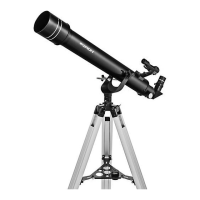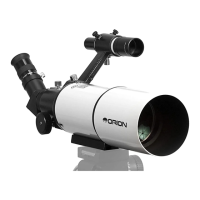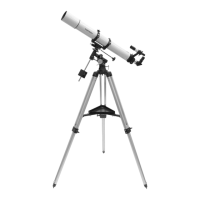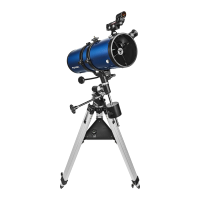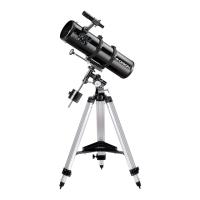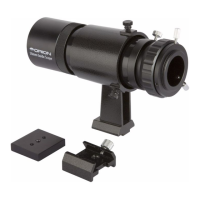9
center the red dot on it. Now, look in the telescope’s eyepiece
and use the slow-motion controls to center it in the eyepiece.
The Dec. slow-motion control cable can move the telescope a
maximum of 25° or so. This is because the Dec. slow-motion
mechanism has a limited range of mechanical travel. (The R.A.
slow-motion mechanism has no limit to its amount of travel.)
If you can no longer rotate the Dec. control cable in a desired
direction, you have reached the end of travel, and the slow-
motion mechanism must be reset. This is done by rst rotating
the control cable several turns in the opposite direction from
which it was being turned. Then, manually slew the telescope
closer to the object you wish to observe (remember to rst
loosen the Dec. lock knob). You should now be able to use the
Dec. slow-motion control cable again to ne adjust the tele-
scope’s position.
Tracking Celestial Objects
When you observe a celestial object through the telescope,
you’ll see it drift slowly across the eld of view. To keep it in the
eld, assuming your equatorial mount is polar aligned, just turn
the R.A. slow-motion control cable clockwise, if the slow-motion
cable is mounted on the EAST side of the mount. If it’s on the
WEST side of the mount, turn it counterclockwise to track. The
Dec. slow-motion control cable is not needed for tracking. Objects
will appear to move faster at higher magnications, because the
eld of view is narrower.
Optional Electronic Drives for Automatic Tracking
An optional DC electronic drive can be mounted on the R.A. axis
of the equatorial mount to provide hands-free tracking. Objects
will then remain stationary in the eld of view without any manual
adjustment of the R.A. slow-motion control cable.
Understanding the Setting Circles
The two setting circles (Figure 18) on an equatorial mount
enable you to locate celestial objects by their “celestial coordi-
nates”. Every object resides in a specic location on the “celestial
sphere”. That location is denoted by two numbers: its right ascen-
sion (R.A.) and declination (Dec.). In the same way, every loca-
tion on Earth can be described by its longitude and latitude. R.A.
is similar to longitude on Earth, and Dec. is similar to latitude. The
R.A. and Dec. values for celestial objects can be found in any star
atlas or star catalog.
The mount’s R.A. setting circle is scaled in hours, from 1 through
24, with small marks in between representing 10-minute incre-
ments. The numbers closest to the R.A. axis gear apply to view-
ing in the Southern Hemisphere, while the numbers above them
apply to viewing in the Northern Hemisphere.
Figure 18. Components of the equatorial mount, seen from both sides.
R.A. Slow-motion cable
Dec. Slow-
motion
cable
Dec. Slow-
motion
cable
Dec. lock
knob
Dec. Setting circle
R.A.
Setting
circle
R.A. Setting
circle
R.A. lock
knob
Latitude
scale
Latitude
lock knob
Latitude
adjustment
bolt
Azimuth
lock knob
Declination (Dec.) axis
Declination (Dec.) axis
Figure 19. Balance the telescope on the R.A. axis by positioning
it as shown and sliding the counterweight until balance is achieved.
R.A. lock knob
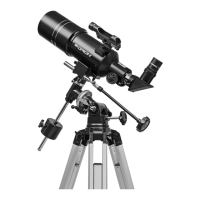
